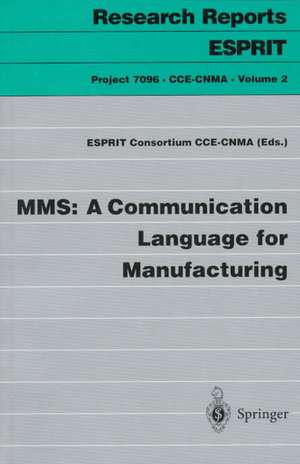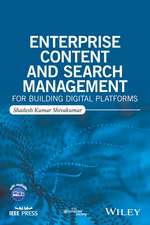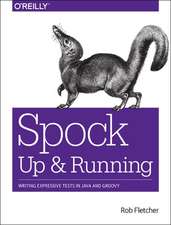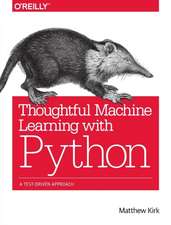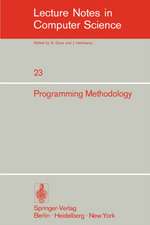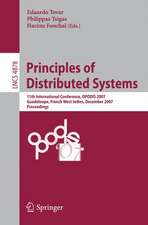MMS: A Communication Language for Manufacturing: Research Reports Esprit, cartea 2
Editat de Consortium CCE-CNMAen Limba Engleză Paperback – 14 iul 1995
Din seria Research Reports Esprit
- 20%
 Preț: 332.71 lei
Preț: 332.71 lei - 20%
 Preț: 644.81 lei
Preț: 644.81 lei - 20%
 Preț: 334.20 lei
Preț: 334.20 lei -
 Preț: 382.36 lei
Preț: 382.36 lei - 20%
 Preț: 478.74 lei
Preț: 478.74 lei - 20%
 Preț: 647.28 lei
Preț: 647.28 lei - 20%
 Preț: 325.63 lei
Preț: 325.63 lei - 20%
 Preț: 324.64 lei
Preț: 324.64 lei - 20%
 Preț: 650.73 lei
Preț: 650.73 lei - 20%
 Preț: 339.80 lei
Preț: 339.80 lei - 20%
 Preț: 641.49 lei
Preț: 641.49 lei -
 Preț: 387.38 lei
Preț: 387.38 lei - 20%
 Preț: 337.52 lei
Preț: 337.52 lei - 20%
 Preț: 328.79 lei
Preț: 328.79 lei - 20%
 Preț: 325.30 lei
Preț: 325.30 lei - 20%
 Preț: 642.19 lei
Preț: 642.19 lei - 20%
 Preț: 640.19 lei
Preț: 640.19 lei - 20%
 Preț: 330.10 lei
Preț: 330.10 lei - 20%
 Preț: 639.52 lei
Preț: 639.52 lei - 20%
 Preț: 329.11 lei
Preț: 329.11 lei - 20%
 Preț: 327.29 lei
Preț: 327.29 lei - 20%
 Preț: 641.87 lei
Preț: 641.87 lei - 20%
 Preț: 335.18 lei
Preț: 335.18 lei - 20%
 Preț: 326.13 lei
Preț: 326.13 lei - 20%
 Preț: 323.34 lei
Preț: 323.34 lei - 20%
 Preț: 331.58 lei
Preț: 331.58 lei - 20%
 Preț: 644.15 lei
Preț: 644.15 lei - 20%
 Preț: 639.85 lei
Preț: 639.85 lei - 20%
 Preț: 322.35 lei
Preț: 322.35 lei - 20%
 Preț: 645.31 lei
Preț: 645.31 lei - 15%
 Preț: 644.49 lei
Preț: 644.49 lei - 20%
 Preț: 327.44 lei
Preț: 327.44 lei - 20%
 Preț: 645.47 lei
Preț: 645.47 lei - 20%
 Preț: 640.19 lei
Preț: 640.19 lei - 20%
 Preț: 345.59 lei
Preț: 345.59 lei - 20%
 Preț: 331.58 lei
Preț: 331.58 lei - 20%
 Preț: 328.60 lei
Preț: 328.60 lei - 20%
 Preț: 334.38 lei
Preț: 334.38 lei - 20%
 Preț: 334.38 lei
Preț: 334.38 lei - 20%
 Preț: 650.27 lei
Preț: 650.27 lei - 15%
 Preț: 657.90 lei
Preț: 657.90 lei - 20%
 Preț: 326.78 lei
Preț: 326.78 lei - 20%
 Preț: 656.84 lei
Preț: 656.84 lei - 20%
 Preț: 647.79 lei
Preț: 647.79 lei - 20%
 Preț: 333.04 lei
Preț: 333.04 lei - 20%
 Preț: 335.18 lei
Preț: 335.18 lei - 20%
 Preț: 645.47 lei
Preț: 645.47 lei - 20%
 Preț: 325.48 lei
Preț: 325.48 lei - 20%
 Preț: 658.98 lei
Preț: 658.98 lei
Preț: 640.69 lei
Preț vechi: 800.86 lei
-20% Nou
Puncte Express: 961
Preț estimativ în valută:
122.61€ • 127.54$ • 101.22£
122.61€ • 127.54$ • 101.22£
Carte tipărită la comandă
Livrare economică 14-28 aprilie
Preluare comenzi: 021 569.72.76
Specificații
ISBN-13: 9783540590613
ISBN-10: 3540590617
Pagini: 200
Ilustrații: XII, 185 p. 32 illus.
Dimensiuni: 155 x 235 x 11 mm
Greutate: 0.29 kg
Ediția:1995
Editura: Springer Berlin, Heidelberg
Colecția Springer
Seriile Research Reports Esprit, Project 7096. CCE-CNMA
Locul publicării:Berlin, Heidelberg, Germany
ISBN-10: 3540590617
Pagini: 200
Ilustrații: XII, 185 p. 32 illus.
Dimensiuni: 155 x 235 x 11 mm
Greutate: 0.29 kg
Ediția:1995
Editura: Springer Berlin, Heidelberg
Colecția Springer
Seriile Research Reports Esprit, Project 7096. CCE-CNMA
Locul publicării:Berlin, Heidelberg, Germany
Public țintă
ResearchCuprins
1. Introduction.- 1.1 The need for standards.- 1.2 Motivation for the book.- 1.3 Purpose of the book.- 1.4 Organisation of the book.- 1.5 Acknowledgements.- 2. Rationale and Context.- 2.1 Rationale for MMS.- 2.2 The OSI reference model.- 2.3 MAP and CNMA.- 2.4 Mini-MAP.- 2.5 Profibus.- 2.6 Summary.- 3. Manufacturing Message Specification (MMS).- 3.1 Basics.- 3.2 The MMS object model.- 3.3 Confirmed and unconfirmed services.- 3.4 The MMS-related standards.- 3.5 Summary.- 4. MMS Core Object Classes.- 4.1 Virtual Manufacturing Device (VMD).- 4.2 Domains.- 4.3 Program invocations.- 4.4 MMS variables.- 4.5 Summary.- 5. MMS in Real Manufacturing Devices.- 5.1 Introduction.- 5.2 The Siemens MMS implementation for SIMATIC PLCs.- 5.3 The Siemens MMS implementation for SINUMERIK NCs.- 5.4 The Télémécanique MMS implementation for TSX 47 PLCS.- 5.5 Comparison of the two PLC MMS implementations.- 5.6 Summary.- 6. Use of MMS in a Real Manufacturing Application.- 6.1 Overview.- 6.2 Rail guided vehicle (RGV).- 6.3 Machining centre.- 6.4 Summary.- 7. MMSI.- 7.1 Introduction.- 7.2 The main benefits of a standard API.- 7.3 Purpose and scope of MMSI.- 7.4 Properties of MMSI.- 7.5 Classes of MMSI functions.- 7.6 Naming rules for MMSI functions.- 7.7 Context-sensitive functions.- 7.8 Support functions.- 7.9 Context-free functions.- 7.10 Parameters of MMSI functions.- 7.11 Synchronous and asynchronous modes.- 7.12 DCB management.- 7.13 MMSI main data types.- 7.14 MMSI objects and handles.- 7.15 Reading a variable.- 7.16 Summary.- 8. A DDE Interface to MMS.- 8.1 Introduction.- 8.2 Windows DDE basics.- 8.3 The MMS/DDE application interface.- 8.4 Operation of the MMS/DDE server.- 8.5 Example: calling MMS in an Excel spreadsheet.- 8.6 Summary.- 9. Other MMS Objects and Services.- 9.1 Operatorstations.- 9.2 Semaphores.- 9.3 Events.- 9.4 Journals.- 9.5 Summary.- 10. Conclusion.- 10.1 What has been discussed.- 10.2 Why is MMS important?.- 10.3 Where is MMS being applied?.- 10.4 What is MMS used for?.- 10.5 What are the main benefits of using MMS?.- 10.6 What about interoperability?.- 10.7 Where can I obtain more information?.- 10.8 So, what of the future?.- Glossary of Terms.- Appendix 1. The MMS and CNMA Information Servers.- Appendix 2. MMSI Context Sensitive Functions.
